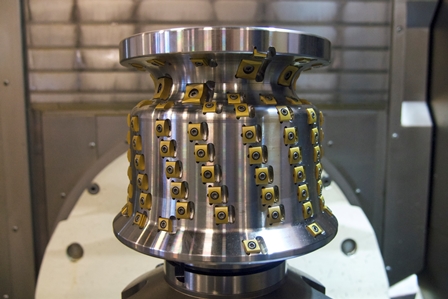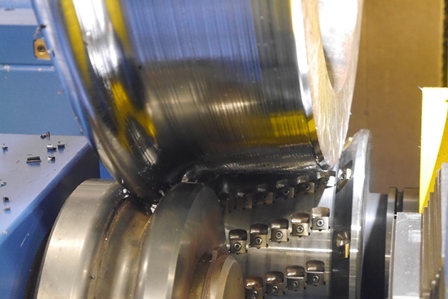 Simmons Machine Tool Corp., a machine tool builder for the railway industry, needed to upgrade its production capacity and was investigating 5-axis mill-turn machining centers to achieve this goal.
Simmons Machine Tool Corp., a machine tool builder for the railway industry, needed to upgrade its production capacity and was investigating 5-axis mill-turn machining centers to achieve this goal.
The Albany, NY, based company, part of the NSH Group, had stringent standards when it came to issues such as chip fall, robustness, accuracy, and consistency, and scanned the market looking for 5-axis machines to meet its needs. After initially reviewing the market for machines used in the tool-and-die mold market, the company ultimately decided to purchase a GROB G550T 5-axis universal mill-turn machining center from Grob, a German company with U.S. offices in Bluffto, Ohio, as the machine was built for highly demanding manufacturing applications.
Machining for machine tools
Simmons needed a 5-axis machine to turn and mill precise products such as its profile milling cutters for underfloor wheel re-profiling machines. The company turns and mills these cutters from 12” diameter solid stock 4150 steel, hardened to about 300 BHN. The cutters are then used on Simmons’ Stanray machines, supplied to freight railway, metro, and transit passenger railway customers around world.
Weighing 22.5 tons, the Stanray machine is mounted in a pit under the rail so that a locomotive can be positioned on top of the machine. The profile milling cutters then re-profile the wheels, which are often in poor condition with flat spots on the tread caused by wheel slippage or emergency braking. The flat spots, which are work hardened areas about the size of a quarter, are for higher in measured hardness compared to the rest of the wheel surface. The cutters themselves, then, must be extremely robust, just as the machines that produce them must be.
 “We reviewed several different 5-axis machines, and most couldn’t keep up with the demands of our application,” said David William Davis, company president and COO. “We make a lot chips when we make a cutter, so chip containment and evacuation from the machine tool is important, and many just didn’t measure up.”
“We reviewed several different 5-axis machines, and most couldn’t keep up with the demands of our application,” said David William Davis, company president and COO. “We make a lot chips when we make a cutter, so chip containment and evacuation from the machine tool is important, and many just didn’t measure up.”
The company found that 5-axis machining centers with vertical spindle orientations tended to have more surfaces and areas for chips to collect on, which prevented easy chip evacuation. Additionally, many 5-axis machines were focused on die and mold production rather than heavy duty metal cutting, and so couldn’t hold up to the railway machine application.
“Overall machine robustness and dependability was also an issue, primarily involving spindle bearing contamination and related failures,” Davis added. “Last, we found that with many 5 axis machine builders, locally available service plus quality remote or virtual service was often simply not available.”
Finding a good fit with GROB
After rejecting several 5-axis machines with vertical spindle orientations that did not meet its needs, the team at Simmons met with a representative from GROB, who presented the company’s horizontal spindle 5-axis universal mill-turn machines.
Simmons chose GROB’s 5-axis machining technology that has a horizontal spindle configuration allowing for optimal chip flow, features intuitive programming, and delivers consistency and accuracy.
Davis said a key reason for purchasing the GROB 5-axis machine was the horizontal spindle axis. “The horizontal spindle configuration, plus the overall design of the machining area, permits optimal chip flow and evacuation and unattended running, all of which are extremely important in our manufacturing processes.”
In addition, he said the machine can achieve better dimensional consistency with the G550T. As an example, one key dimension on the Stanray profile milling cutter has to be turned to +0.0000, -0.0005”. "After a short time using the G550T, we simply eliminated probing this feature because our confidence in hitting this dimension repeatedly is so high,” Davis said.
Saving time, saving money
Implementing GROB’s 5-axis machining technology has translated into cost savings and efficiency benefits. Downtime was dramatically reduced, since the GROB G550T is built to withstand the demands of Simmons’ manufacturing processes and materials. Given that they are used to machine consumable parts, the G550T’s design factors for uptime are important to manufacturing efficiency and cost optimization. In addition, the GROB machine can be operated unattended.
Another important ingredient for meeting and exceeding ROI goals has been the G550T’s accuracy and consistency; the machine is so accurate that individual components do not need to be measured for accuracy, thus reducing measuring time as well as non-value-added time in the production stream. In addition, reduced vibration at the tool tip translates into extended tool life, accuracy, and consistency, the company says.
As a company that builds machine tools, Simmons was uniquely positioned as a machine tool building seeking equipment from another machine tool builder to enable accurate and efficient tool manufacturing. The company had stringent standards when they researched 5-axis machines and were seeking a 5-axis machine that could keep up with difficult materials and processes. After extensive research, the company purchased the GROB G550T 5-axis universal mill-turn machining center that offered benefits in terms of chip fall and evacuation, service, intuitive programming, and exceptional reliability and consistency.
Contact Details
Related Glossary Terms
- centers
centers
Cone-shaped pins that support a workpiece by one or two ends during machining. The centers fit into holes drilled in the workpiece ends. Centers that turn with the workpiece are called “live” centers; those that do not are called “dead” centers.
- flat ( screw flat)
flat ( screw flat)
Flat surface machined into the shank of a cutting tool for enhanced holding of the tool.
- gang cutting ( milling)
gang cutting ( milling)
Machining with several cutters mounted on a single arbor, generally for simultaneous cutting.
- hardness
hardness
Hardness is a measure of the resistance of a material to surface indentation or abrasion. There is no absolute scale for hardness. In order to express hardness quantitatively, each type of test has its own scale, which defines hardness. Indentation hardness obtained through static methods is measured by Brinell, Rockwell, Vickers and Knoop tests. Hardness without indentation is measured by a dynamic method, known as the Scleroscope test.
- machining center
machining center
CNC machine tool capable of drilling, reaming, tapping, milling and boring. Normally comes with an automatic toolchanger. See automatic toolchanger.
- milling
milling
Machining operation in which metal or other material is removed by applying power to a rotating cutter. In vertical milling, the cutting tool is mounted vertically on the spindle. In horizontal milling, the cutting tool is mounted horizontally, either directly on the spindle or on an arbor. Horizontal milling is further broken down into conventional milling, where the cutter rotates opposite the direction of feed, or “up” into the workpiece; and climb milling, where the cutter rotates in the direction of feed, or “down” into the workpiece. Milling operations include plane or surface milling, endmilling, facemilling, angle milling, form milling and profiling.
- milling cutter
milling cutter
Loosely, any milling tool. Horizontal cutters take the form of plain milling cutters, plain spiral-tooth cutters, helical cutters, side-milling cutters, staggered-tooth side-milling cutters, facemilling cutters, angular cutters, double-angle cutters, convex and concave form-milling cutters, straddle-sprocket cutters, spur-gear cutters, corner-rounding cutters and slitting saws. Vertical cutters use shank-mounted cutting tools, including endmills, T-slot cutters, Woodruff keyseat cutters and dovetail cutters; these may also be used on horizontal mills. See milling.
- milling machine ( mill)
milling machine ( mill)
Runs endmills and arbor-mounted milling cutters. Features include a head with a spindle that drives the cutters; a column, knee and table that provide motion in the three Cartesian axes; and a base that supports the components and houses the cutting-fluid pump and reservoir. The work is mounted on the table and fed into the rotating cutter or endmill to accomplish the milling steps; vertical milling machines also feed endmills into the work by means of a spindle-mounted quill. Models range from small manual machines to big bed-type and duplex mills. All take one of three basic forms: vertical, horizontal or convertible horizontal/vertical. Vertical machines may be knee-type (the table is mounted on a knee that can be elevated) or bed-type (the table is securely supported and only moves horizontally). In general, horizontal machines are bigger and more powerful, while vertical machines are lighter but more versatile and easier to set up and operate.

